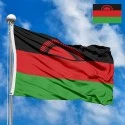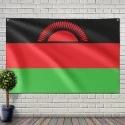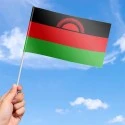The national flag of the Republic of Malawi is a powerful and deeply symbolic emblem, reflecting the nation's journey from colonial rule to independence, its aspirations for progress, and the unique challenges it faces. Adopted on July 6, 1964, upon gaining independence from British rule, the flag is a horizontal tricolor, prominently featuring a rising red sun on its top black stripe. Its design encapsulates the dawn of a new era, the struggles endured, and the bright future envisioned for the Malawian people.
Design and Symbolism: Colors of a Nation's Spirit and Struggle
The flag of Malawi is composed of three horizontal stripes of equal width, with a distinctive emblem in the top stripe:
-
Black (Top Stripe): The uppermost black stripe symbolizes the African people themselves. It represents the indigenous population of Malawi and the broader African continent, emphasizing their identity, resilience, and unity. It signifies the pride in their heritage and the recognition of their collective strength as a people who have overcome historical challenges to achieve self-determination.
-
Red (Middle Stripe): The central red stripe is a poignant tribute to the blood shed in the struggle for liberation. It commemorates the sacrifices made by Malawians and other Africans in their fight for independence from colonial powers. This color embodies the valor, courage, and determination that characterized the nationalist movement, reminding citizens of the cost of their freedom and the importance of safeguarding it.
-
Green (Bottom Stripe): The lowest green stripe represents the lush and fertile land of Malawi. It symbolizes the nation's rich natural resources, its vibrant agriculture, and the hope for prosperity that springs from its earth. Green signifies the environmental beauty of Malawi, its agricultural potential, and the continuous growth and development that are vital for its future.
The Rising Sun (Nyali): A Beacon of Hope and New Beginnings
Within the black stripe, a stylized red rising sun with 31 rays is centrally positioned. This iconic emblem is perhaps the most significant symbol on the flag:
-
Dawn of Independence: The rising sun (known as Nyali in Chichewa) primarily represents the dawn of freedom and independence for Malawi and, more broadly, for the African continent. It signifies that the sun of freedom was rising over Africa at the time of Malawi's independence, marking the end of colonial night and the beginning of a new era of self-governance and hope.
-
Progress and Aspirations: The 31 rays are often said to symbolize the 31 years of colonial oppression that preceded independence, highlighting the arduous journey to freedom. However, it also signifies the potential for growth, progress, and a bright future for the nation, constantly striving towards a new day. It is a powerful message of optimism and renewal.
The combination of these elements creates a flag that is rich in meaning, telling the story of Malawi's past struggles, present identity, and future aspirations in a single, compelling design.
Dimensions and Proportions:
The official proportions of the Flag of Malawi are a width-to-length ratio of 2:3. This is a standard ratio commonly used for national flags worldwide, contributing to its balanced and dignified appearance. Each of the three horizontal stripes (black, red, and green) is of equal height, ensuring visual balance. The red rising sun is proportionally sized to be prominent within the black stripe without overwhelming it, maintaining the overall aesthetic harmony of the flag.
History and Evolution: From Colonial Rule to Self-Determination
The history of the Malawian flag is intrinsically linked to the nation's struggle for self-governance and its emergence as an independent state.
-
Nyasaland Protectorate (Pre-1964): Before its independence, Malawi was known as Nyasaland, a British protectorate. During this period, the flag used was the British Blue Ensign, defaced with the badge of Nyasaland. This badge typically featured a leopard and a rising sun motif, hinting at the future national symbol.
-
Gaining Independence (July 6, 1964): On July 6, 1964, Nyasaland achieved full independence from the United Kingdom and was renamed Malawi. With independence came the adoption of a new national flag. The design was conceived and championed by Dr. Hastings Kamuzu Banda, Malawi's first President, who led the country to independence. The choice of colors and the rising sun motif were deliberate to symbolize the new dawn of freedom for the nation.
-
Proposed Change (2010) and Reversion (2012): In July 2010, there was a controversial proposal by the then-President Bingu wa Mutharika to change the flag. The proposed new flag featured horizontal stripes of red, black, and green, with a full white sun in the center of the red stripe. This change was intended to symbolize that Malawi had achieved full independence and was no longer "rising" but had "fully risen." However, this change was unpopular with many Malawians who viewed the original flag as sacred and representative of their unique history. Following Mutharika's death in 2012, the new President, Joyce Banda, quickly announced the reversion to the original independence flag, effective May 28, 2012. This decision was met with widespread approval and reaffirmed the deep attachment of the Malawian people to their original national symbol.
-
Current Status: The flag adopted in 1964 remains the official flag of Malawi today, a testament to its enduring significance and the will of the people.
Regional Context and Southern African Identity:
Malawi is a landlocked country in Southeast Africa, bordered by Tanzania to the north, Mozambique to the east and south, and Zambia to the west. Its flag shares a thematic resemblance with other flags of newly independent African nations, particularly in the use of Pan-African colors (black, red, green, and sometimes yellow) to represent a shared history of struggle against colonialism and aspirations for a united, prosperous Africa.
While the specific arrangement and the unique "rising sun" emblem make Malawi's flag distinctive, it resonates with the broader spirit of post-colonial identity in Southern and East Africa. Many flags in the region incorporate elements that speak to the land, the people, and the struggle for freedom. The Malawian flag stands out for its specific depiction of the "rising sun," which clearly marks it as a symbol of a new beginning, relevant not just to Malawi but also to the narrative of African liberation. This makes it a unique yet harmonizing presence within the rich tapestry of African national flags.
Interesting Facts:
-
Independence Flag: The current flag was adopted on July 6, 1964, the day Malawi gained independence from British rule.
-
First President's Vision: The design was championed by Malawi's first President, Dr. Hastings Kamuzu Banda.
-
Symbol of New Dawn: The rising sun (Nyali) symbolizes the dawn of freedom for Malawi and the entire African continent.
-
31 Rays: The 31 rays of the sun are often said to represent the 31 years of colonial oppression before independence.
-
Controversial Change and Reversion: The flag was briefly changed between 2010 and 2012 to a different design before reverting to the original, much to the relief and approval of the Malawian populace.
-
"Warm Heart of Africa": Malawi is known as the "Warm Heart of Africa," a sentiment that aligns with the welcoming and hopeful symbolism of its flag.
-
Pan-African Elements: While not a strict Pan-African tricolor (like Ghana or Senegal), it incorporates the core colors of black (people), red (struggle), and green (land) widely used across the continent.
-
Lake Malawi: The country is named after Lake Malawi, a prominent geographical feature, and the flag's green stripe implicitly represents the nation's natural beauty and resources, including this vast lake.
-
Simplicity and Power: The flag's simple yet deeply symbolic design makes it easily recognizable and impactful.
Significance for the Inhabitants: A Banner of Identity, Freedom, and Hope
For the people of Malawi, their national flag is more than just a piece of cloth; it is a profound and cherished emblem that encapsulates their history, their identity, and their collective aspirations. It is a constant reminder of the arduous journey to freedom and the enduring spirit of their nation.
The black stripe proudly represents the Malawian people and their African heritage. It evokes a sense of unity, resilience, and pride in their roots, reminding them of who they are and the collective strength they possess. This color signifies their self-determination and their place as a sovereign nation among the global community.
The red stripe speaks to the sacrifices made for their liberty. It is a solemn reminder of the blood shed and the struggles endured by generations to secure independence. This makes the flag a sacred symbol, instilling a deep sense of gratitude for freedom and a commitment to preserving it for future generations. It fosters courage and a willingness to stand firm in the face of challenges.
The green stripe represents the land itself – the source of life, sustenance, and future prosperity. It symbolizes the natural beauty of Malawi, its agricultural potential, and the hope for growth and development. This connection to the land provides a sense of belonging and responsibility, encouraging stewardship of their environment for sustainable progress.
The most potent symbol, the red rising sun, is a beacon of hope. It signifies the dawn of a new era, not just for Malawi but for Africa, inspiring optimism for a brighter future. It reminds Malawians that despite past hardships, a new day always comes, full of possibilities and the promise of continued advancement. This symbol strengthens their resolve to work together for national development and to overcome obstacles.
When displayed, whether at national events, in schools, or during everyday life, the flag unites Malawians across diverse backgrounds. It fosters a shared sense of national identity, encouraging patriotism and a collective commitment to peace, progress, and the well-being of their nation. The flag is a living testament to their hard-won freedom, a guiding light for their aspirations, and a cherished embodiment of their unique place in the world.
In the demonstration images, full-size flags are shown with proportions of 2:3, and hand-held flags with proportions of 1:2.







 Waving flag
Waving flag
 Sizes:
Sizes:
 Round flag
Round flag
 Sizes:
Sizes:
 Rectangular flag 2:3
Rectangular flag 2:3
 Sizes:
Sizes: